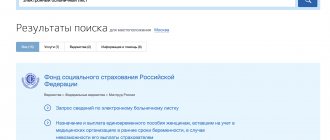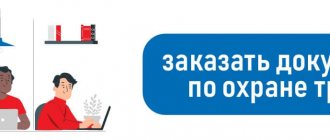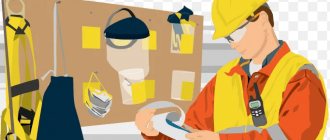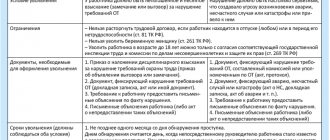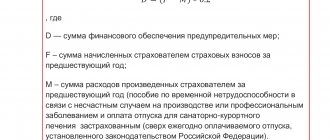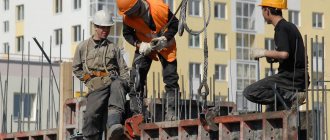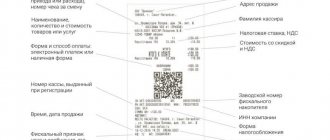At the end of the year, a plan for inspections of legal entities and individual entrepreneurs for the next year is officially published on the websites of the territorial branch of the Prosecutor's Office, and, of course, no one wants to find their company on the lists, especially if everything is not going smoothly for you.
If you are subject to inspection next year, then you need to restore order in labor protection at the enterprise as soon as possible, because it is not yet known exactly how inspections will be carried out in 2022. This could be a check using GIT checklists with changes from 2022, but not updated after the changes to the POT came into force, or other possible tools (I will give an explanation after the list of checklists for the race).
GIT checklists (full list)
The first way to prepare for an imminent visit by a labor inspector is to download the GIT checklists, which are currently not updated due to the Labor Safety Rules that have come into force, but at the same time continue to be in effect.
However, you can download those that are specific to your company and begin self-testing using the documents listed in them.
Occupational safety checklists contain a complete list of questions that may be of interest to the inspector, a list of documents and materials that must be developed and implemented at the enterprise, for submission to the state labor inspectorate for review.
For each GIT checklist, I left a link to the document in Google Drive, by clicking on the number of each, you can familiarize yourself with it, if necessary, download, print or add the document at the same time to your Google Drive.
It’s very convenient for me to use it this way, but if anything is unclear to you, please contact me in the comments.
List of GIT checklists approved by Rostrud Order No. 655 and edited by Rostrud Order No. 153 dated 03.08.20:
- all PL in one folder;
- CL No. 1 “Checking the correctness of employment”;
- ChL No. 2 “Control of the content of employment contracts”;
- ChL No. 3 “Checking the correctness of making adjustments to employment contracts”;
- ChL No. 4 “Checking the termination of employment contracts”;
- ChL No. 5 “Control over the established operating hours and recording of working hours”;
- ChL No. 6 “Checking the correctness of the provision of annual paid leave”;
- ChL No. 7 “Supervision over the calculation and payment of wages”;
- ChL No. 8 “Control over the implementation of labor of minors”;
- ChL No. 9 “Control over the implementation of labor of foreign workers”;
- ChL No. 10 “Control over the implementation of labor of disabled people”;
- ChL No. 11 “Control over the labor of women and persons with family responsibilities”;
- ChL No. 12 “Control over the implementation of labor of persons working in the Far North and in areas equivalent to it”;
- ChL No. 13 “Supervision over working hours”;
- ChL No. 14 “Control of the correctness of dismissals of employees during layoffs”;
- ChL No. 15 “Control over the provision of annual additional vacation";
- ChL No. 16 “Control over the provision of other rest (not taking into account annual paid leave)”;
- ChL No. 17 “Supervision over deductions from wages”;
- ChL No. 18 “Supervision over the organization of underground work, as well as hazardous working conditions”;
- ChL No. 19 “Control over involvement in work beyond working hours”;
- ChL No. 20 “Control over the organization of investigations and recording of NS, occupational diseases”;
- ChL No. 21 “Supervision of the implementation of special assessment and assessment”;
- ChL No. 22 “Control of notification of employees about conditions and occupational safety in the Republic of Moldova, about the risks of harm to health, provision of guarantees, compensation and personal protective equipment”;
- ChL No. 23 “OT control at altitude”;
- ChL No. 24 “Control of safety during operation of electrical installations”;
- ChL No. 25 “Work safety control for construction work”
- ChL No. 26 “Control of occupational safety in agriculture”;
- ChL No. 27 “Supervision of preliminary and periodic medical examinations”;
- ChL No. 28 “Supervision of OT training”;
- ChL No. 29 “Work safety control for loading and unloading operations”;
- ChL No. 30 “Supervision over the acquisition, issuance and use of certified and declared PPE and VKZ”;
- ChL No. 31 “Supervision over the creation and operation of an OSMS”;
- ChL No. 32 “Supervision of ensuring the work and rest regime of employees”;
- ChL No. 33 “Supervision over the provision of sanitary services and medical services. provision of employees”;
- ChL No. 34 “Control of the development and approval of rules and instructions on occupational safety for employees (clause no longer in force)”
- ChL No. 35 “Control over the availability of a set of legal regulations that have labor safety requirements for the organization’s profile of activity”;
- ChL No. 36 “Monitoring the implementation of occupational safety and working conditions in the Republic of Moldova”;
- ChL No. 37 “Monitoring the timely familiarization of employees with occupational safety requirements”;
- ChL No. 38 “Control of labor safety in housing and communal services”;
- ChL No. 39 “Control of labor safety for electric welding work”;
- ChL No. 40 “Control of labor safety for gas welding work”;
- ChL No. 41 “Control of occupational safety during the operation of thermal power plants”;
- ChL No. 42 “Occupational safety control during the operation of refrigeration units”;
- ChL No. 43 “Control of occupational safety for work in confined or confined spaces”;
- ChL No. 44 “Control of fire safety in vessels operating under pressure”;
- ChL No. 45 “Control of occupational safety for gas-hazardous work”;
- ChL No. 46 “Control of occupational safety for hot work”;
- ChL No. 47 “Control of occupational safety for painting works”;
- ChL No. 48 “Control of safety regulations for underwater blasting”;
- ChL No. 49 “Control of occupational safety for repair work of buildings and structures”;
- ChL No. 50 “Health safety control during the operation of water supply and sanitation networks”;
- ChL No. 51 “Control of occupational pollution with pesticides (pesticides) and mineral fertilizers”;
- ChL No. 52 “Control of occupational safety in chemicals.” laboratories”;
- ChL No. 53 “Installation control, technical. maintenance and repair of technological equipment”;
- ChL No. 54 “Control of labor safety for repair work and maintenance of lifting machines”;
- ChL No. 55 “Occupational safety control during painting activities”;
- ChL No. 56 “Occupational safety control during the operation of boiler houses”;
- ChL No. 57 “Occupational safety control during the operation of gas facilities”;
- ChL No. 58 “Health safety control during the operation of fuel oil facilities”;
- ChL No. 59 “Health safety control during the operation of solid fuel warehouses”;
- ChL No. 60 “Occupational safety control during activities related to technological transport”;
- ChL No. 61 “Occupational safety control during activities related to tools and devices”;
- ChL No. 62 “Control of occupational safety for logging, forestry work and woodworking”;
- ChL No. 63 “Control of occupational safety in sea and river ports”;
- ChL No. 64 “Control of earthworks”;
- ChL No. 65 “Work safety control during the operation of conveyors”;
- ChL No. 66 “OT Control for charging and maintenance of batteries”;
- ChL No. 67 “Warehouse safety control”;
- ChL No. 68 “OT control for draining and loading of petroleum products”;
- ChL No. 69 “OT control for maintenance, repair and inspection of the condition of vehicles”;
- ChL No. 70 “Control of labor protection for the transportation of goods and passengers using vehicles”;
- ChL No. 71 “Health safety control during the operation of trucks”;
- ChL No. 72 “Occupational safety control during the operation of in-plant transport”;
- ChL No. 73 “Work safety control during installation work”;
- ChL No. 74 “Work safety control in the manufacture and assembly of metal structures”;
- ChL No. 75 “Occupational safety control during cold processing of metals”;
- ChL No. 76 “Occupational safety control during the use and maintenance of machine-building production equipment”;
- ChL No. 77 “Occupational safety control in foundry production”;
- ChL No. 78 “Work safety control in mechanical engineering”;
- ChL No. 79 “Health safety control during the repair of bridges and overpasses”;
- ChL No. 80 “Occupational safety control during maintenance and repair of intra-port transport”;
- ChL No. 81 “Health safety control during the operation of machines and mechanisms in the port territory”;
- ChL No. 82 “Occupational safety control during the operation of lifting machines and mechanisms”;
- ChL No. 83 “Control of plumbing and plumbing work”;
- ChL No. 84 “Work safety control for dry cleaning and washing”;
- ChL No. 85 “Work safety control when using a bulldozer”;
- ChL No. 86 “Control of labor safety when using an excavator”;
- ChL No. 87 “OT Control when using a tractor”;
- ChL No. 88 “Health safety control during road repairs”;
- ChL No. 89 “Control of OT when using the skating rink”;
- ChL No. 90 “Work safety control when laying asphalt concrete”;
- ChL No. 91 “Control of traffic safety during road markings”;
- ChL No. 92 “Work safety control in a printing organization”;
- ChL No. 93 “OT Control in soldering, tinning, surfacing”;
- ChL No. 94 “Work safety control on metalworking machines and equipment”;
- ChL No. 95 “Health safety control during the use, transportation and storage of liquefied gas cylinders and gas cylinders”;
- ChL No. 96 “Work safety control in cement production”;
- ChL No. 97 “Health safety control during milk processing”;
- ChL No. 98 “Work safety control during the production of bakery and pasta products”;
- ChL No. 99 “Health and safety control during the production of alcoholic and non-alcoholic products”;
- ChL No. 100 “Supervision over the provision of measures during the prevention of emergency situations, preserving the life and health of workers in the event of such situations, including when providing first aid to victims”;
- ChL No. 101 “Other safety control during gas-flame processing of metals”;
- ChL No. 102 “OT Control during spraying and application of metal coatings”;
- ChL No. 103 “OT Control during Heat Treatment of Metals”;
- ChL No. 104 “Occupational safety control during repair and maintenance of agricultural machinery”;
- ChL No. 105 “Control of trade warehouses, bases and refrigerators”;
- ChL No. 106 “Control of occupational safety in urban electric transport”;
- ChL No. 107 “Supervision over the provision of guarantees to health workers”;
- ChL No. 108 “Supervision over the registration of financial liability”;
- ChL No. 109 “Supervision over the provision of guarantees for workers employed by individuals - individual entrepreneurs”;
- ChL No. 110 “Control from the coal industry”;
- ChL No. 111 “Supervision over the provision of guarantees to creative workers”;
- ChL No. 112 “Supervision over the provision of guarantees to athletes and coaches”;
- ChL No. 113 “Control of OT of vocational education and additional enterprises. vocational education, advanced training of workers, conclusion of student contracts”;
- ChL No. 114 “Supervision over the correctness of the implementation of special assessments by organizations conducting a special assessment of working conditions”;
- ChL No. 115 “Work safety control during the extraction of sand and gravel materials on floating mining equipment”;
- ChL No. 116 “Health safety control during storage, transportation and sale of petroleum products”;
- ChL No. 117 “Control of labor safety during the operation of gas stations”;
- ChL No. 118 “OT Control at linear structures of cable transmission lines”;
- ChL No. 119 “OT Control on radio relay communication lines”;
- ChL No. 120 “Control of public catering”;
- ChL No. 121 “Control from the oil and fat industry”;
- ChL No. 122 “Health safety control at meat industry enterprises”;
- ChL No. 123 “Occupational safety control in the production of sugar, molasses and confectionery products”;
- ChL No. 124 “Health safety control during the production of fruit and vegetable products”;
- ChL No. 125 “Control of OT during the release of juices”;
- ChL No. 126 “HSE control for plastics processing industries”;
- ChL No. 127 “Occupational safety control in tobacco production”;
- ChL No. 128 “Control of occupational safety in asbestos-producing organizations, materials and products containing them”;
- ChL No. 129 “Control of occupational safety in the extraction (catch), processing of aquatic biological resources and the release of certain types of products from aquatic biological resources”;
- ChL No. 130 “Work safety control for light industry”;
- ChL No. 131 “Work safety control during finishing work”;
- ChL No. 132 “Occupational safety control during roofing work”;
- ChL No. 133 “Control of security (protection) of objects and (or) property.”
What the experts say
We asked for comments on the new service from those who will actually use it - HR experts and organizational leaders.
According to HR auditor Olga Slinkina , the Electronic Inspector service really helps to conduct a preliminary check of violations. But it weakly correlates with Rostrud questionnaires, emphasizes the expert on personnel records management and labor law. For example, in the work application form there is a question about civil-labor contracts, but when completing a similar survey topic on the Electronic Inspector service, this question does not automatically arise. In addition, there are questions that are formulated for specialists. For example, a question about working conditions: “Are your working conditions harmful or dangerous?” A simple employee will answer “Yes,” because he has a harmful boss, he forces him to work a lot and sometimes shouts. And it is understood that any employee can check their working conditions, correctly indicate the name of the organization and send it to the labor inspectorate online. And there is a possibility (it is not yet very high) that the State Tax Inspectorate will come with an inspection to this organization.
In addition, based on the results of filling out the questionnaire, a report is obtained that can be printed and shown to the manager. But the fines specified there are small, from the employer’s point of view: from 30,000 to 150,000 rubles maximum (according to a special assessment). However, there is a Letter dated 03/07/2018 No. 837-TZ of the Ministry of Labor and Social Protection, the Federal Labor Service, the appendix to which is guidelines for the use of GIT questionnaires. And it clearly states that one sheet is filled out per employee. That is, if there are 50 people in a company, then 50 sheets about hiring, 50 sheets about drawing up an employment contract, etc. must be filled out. And everything that relates to the special violation, for example, part 4 of article 5.27 of the Code of Administrative Offenses of the Russian Federation (improper registration of an employment contract), will be considered for each violation in the contract and for each contract separately, and the fines will multiply. This is not reflected anywhere in the final protocol of the survey, and not every personnel officer follows Rostrud Letters, so he will not be able to convey this idea to his superiors.
General Director of Foros Audit LLC Elena Vasilyeva , in turn, says that the Electronic Inspector service should be considered from several points of view. The plus side is that he has appeared, and he can become an excellent assistant. It is already widely known in legal reference systems, and in general it is convenient that there is a service that presents the forms necessary for an enterprise in any situation, where there is an online assistant where it is possible to check your employment contract. But there are also disadvantages. For example, there is no online way to fill out a complete package of documents for your work situation.
Elena Vasilyeva also emphasizes that entrepreneurs often live in the illusion that they will certainly bypass all checks and fines. In addition, the reason for the reluctance to delve into the nuances of labor legislation is a simple lack of time and concern to stay “afloat”, making money today. That is why many are still hoping for a Russian “maybe” and do not pay due attention to personnel documentation. But the “Electronic Inspector” service offers a look at the entire document flow of the HR officer not through the eyes of the employee preparing the documents, but from the position of the inspector: what needs to be done and in what order, following clear instructions and legal provisions.
List of acts, compliance with which will be checked during the inspection
Order of the Ministry of Labor No. 655 continues to be in effect, and therefore the checklists, but nevertheless, Order of Rostrud No. 265 has come into force, which approves the List of legal acts that contain mandatory requirements that will be assessed during the inspection of the State Labor Inspectorate and when bringing to administrative responsibility .
You can download and study this list by following the link. It is huge and difficult to navigate, so at the moment there is still no clear understanding of exactly how the checks will be carried out.
And how exactly the GIT check will be carried out in 2022, using checklists or applying order No. 265, is not clear, so it is more correct to prepare according to the “full program”.
About the inspection plan
To find out if you are facing a scheduled inspection, you should visit the website of the regional labor inspectorate office . The plan for next year will appear in December. If you are not on the list for inspection according to the plan, then they can only come to you unscheduled. Such inspections are most often carried out based on complaints from employees or other authorities.
By the way, the fact that the company had an unscheduled inspection does not mean that it will not be included in the plan. After all, the reasons for such checks are different.
How else can you prepare for a GIT test?
In the process of preparing for the GIT inspection, in addition to occupational safety checklists, I can highlight one more method of self-test - this is the electronic inspector of Rostrud.
Today, this service contains 200 GIT checklists on various topics, and you can also use this option for preliminary and independent preparation.
But I personally don’t do this myself, since my personal competence and the professionalism of the team are enough not to overpower, perhaps, my biased attitude about leaking my data and attracting unnecessary attention to my counterparties
